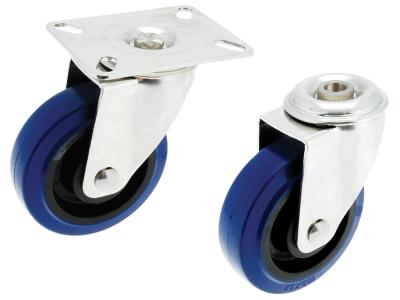
WDS Component Parts Ltd. has launched a new range of free-running castors and wheels that cover a range of sizes, load capacities and materials.
The castors are available in light, medium and heavy-duty capacity models, up to 500kg loads and with wheel diameters 80mm to 200mm. A twin wheel version is available for heavier loads. The bracket types include fixed, swivel and swivel-and-braked options and are available in zinc-coated steel or 304 stainless steel.
The wheels have either nylon or steel centres, the latter being the high strength option, and can be fitted with a plain or ball central bearing. There are a number of material options for the tyres. Gray rubber tyres ensure quiet running, so are favoured for use in hospitals, libraries and offices. Blue rubber is non-marking, making it ideal for clean rooms, show rooms, operating theatres, laboratories and food facilities. For applications where there is a wide environmental temperature range, such as bakeries and heat treatment facilities, WDS recommends phenolic wheels, made of plastic impregnated with layers of, silicone, melamine or epoxies - which can with stand temperatures from -40º C to 280º C.
Nylon wheels are rigid and do not flatten under load, so are best for pushing heavy loads, while fiber-reinforced wheels are quiet, non-marking and able to take heavy loads so are often used in applications where a combination of performance characteristics are required or where frequent washdowns occur.
In addition to these, WDS also offers levelling castors, which can be used to raise the castors so that the equipment itself sits firmly on the floor and is less susceptible to being knocked out of position. These are particularly popular for levelling off equipment when parked on uneven surfaces or for equipment that is not moved often. Theatre stage set designers also like them because they enable props to be moved quickly, easily and quietly onto the stage, then the wheels can be raised so that they are not visible to the audience and the prop is stably positioned.
